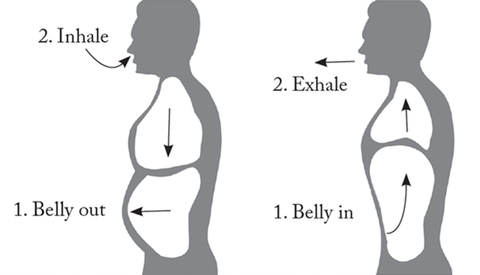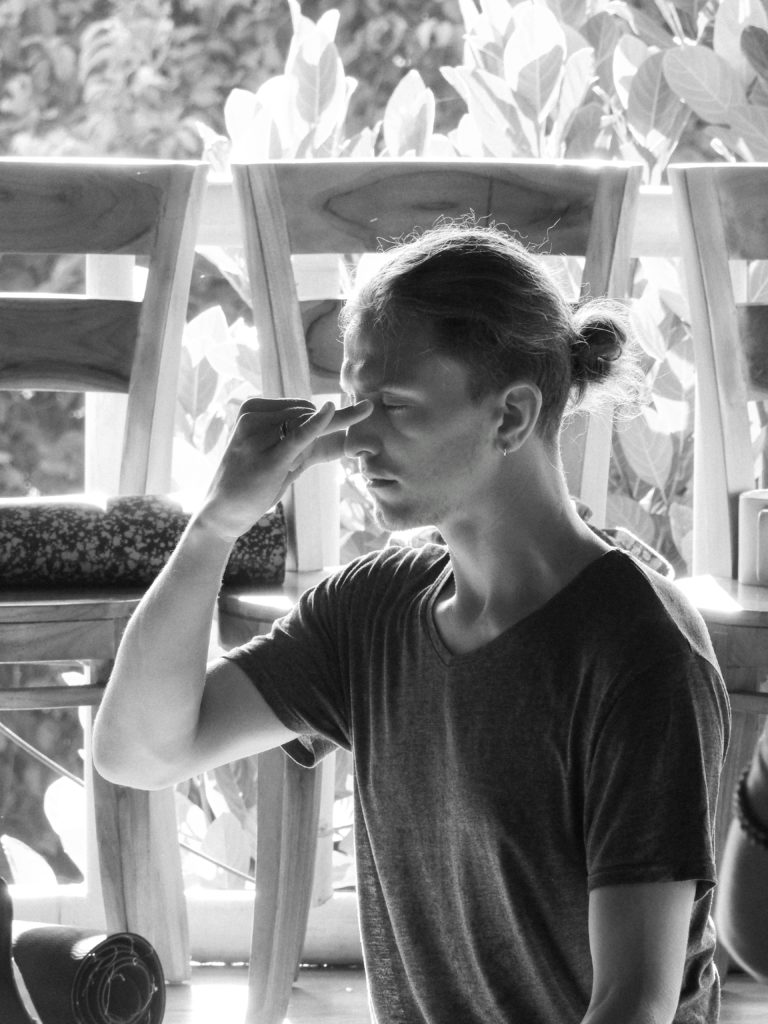The Basics of Pranayama:
Pranayama involves a series of controlled and conscious breathing exercises designed to enhance the flow of prana throughout the body. These techniques can be practiced in various ways, but they all share a common goal: to regulate the breath and bring about a sense of calmness. Some fundamental Pranayama techniques include:
-
Deep Abdominal Breathing (Diaphragmatic Breathing): Focusing on deep, slow breaths that engage the diaphragm helps increase oxygen supply, promoting relaxation and reducing stress.
-
Ujjayi Breathing (Ocean Breath): This involves breathing through the nose with a slight constriction in the throat, creating a sound similar to ocean waves. Ujjayi breathing calms the nervous system and fosters mindfulness.
-
Nadi Shodhana (Alternate Nostril Breathing): By alternating the breath between nostrils, Nadi Shodhana balances the two hemispheres of the brain, promoting mental clarity and reducing anxiety.

Benefits of Pranayama:
-
Stress Reduction: Pranayama activates the parasympathetic nervous system, triggering the relaxation response. This can lower cortisol levels, reduce stress, and contribute to a sense of overall well-being.
-
Improved Respiratory Function: Regular practice of Pranayama enhances lung capacity, promoting more efficient oxygen exchange. This can be particularly beneficial for individuals with respiratory conditions like asthma.
-
Enhanced Mental Clarity: The increased oxygen supply to the brain and the calming effect on the nervous system can sharpen focus, improve concentration, and enhance cognitive function.
-
Emotional Balance: Pranayama helps regulate emotions by calming the mind and reducing the impact of external stressors. This emotional balance can lead to healthier relationships and improved overall mood.
-
Better Sleep: Incorporating Pranayama into your bedtime routine can help calm the mind and promote restful sleep. Deep, rhythmic breathing signals to the body that it is time to relax and unwind.
Incorporating Pranayama Into Your Routine:
To experience the benefits of Pranayama, consider integrating the following practices into your daily routine:
-
Morning Awakening: Start your day with a few minutes of deep breathing to energize your body and mind.
-
Midday Reset: Take short breaks throughout the day for a few rounds of Ujjayi breathing to release tension and maintain focus.
-
Evening Relaxation: Wind down before bedtime with Nadi Shodhana or other calming techniques to prepare your body for a restful night's sleep.
Ujjayi Breath
Ujjayi: Victory Pranayama: Prana – life force, breath; Yama – control, moderation, regulation
Ujjayi (pronounced oo-jai) is commonly translated as “victorious breath” and has been used for thousands of years to enhance the practice of Hatha yoga. Also commonly known as the “ocean breath”, the sound that Ujjayi provides helps us to synchronise the breath with the movements during yoga, making the whole yoga practice more rhythmic.
Ujjayi breathing is in a sense the gateway to Pranayama practices.
In this pranayama, inhalation and exhalation are always done through the nose, with the lips sealed. This, in addition to generating heat in the body, allows the entry and exit of the air to be dosed, taking greater control of each breath. Although the breath passes through the nostrils, the emphasis is on the throat. A constriction should be created in the throat as if you were inhaling and exhaling through a thin straw.
Benefits: calming for the mind, heating for the body. Helps to slow down and lengthen the breath, soothing for the nervous system.
Pranayama
To explain what pranayama means we can look at the literal translation first. It is often split into ‘prana’ and ‘yama’ translating it into ‘breath control’. This is how pranayama is often being explained and taught: merely as a practice of breath control.
However, other authors have made us mindful about the fact that pranayama is actually comprised of the words ‘prana’ and ‘ayama’, which means ‘expanding the pranic capacity’.
Pranayama is more than just controlling the breath, and its purpose is to ‘awaken’ prana which is already present in the body, to balance the flow of prana and thus to maintain a healthy body and mind. That is also reflected in the statement below:
“Pranayama is the link between the mental and physical disciplines. While the action is physical, the effect is to make the mind calm, lucid and steady” - Swami Vishnu-Devananda
It is said that pranayama practice prepares ourselves so that we can become aware of the more subtle levels of our existence. Pranayama calms and strengthens the mind and creates a feeling of internal space. Moreover, according to the yoga sutras, pranayama is an important practice that brings clarity and wisdom:
“Tatah ksiyate prakasa avaranam”
(YS II.52)
“Pranayama removes the veil covering the light of knowledge and heralds the dawn of wisdom.“
“Dharanasu ca yogyata manasah”
(YS II.53)
“The mind also becomes fit for concentration.“
Before we continue, first a word about prana: by breathing we do not only inhale air but prana as well. Prana can be explained as subtle energy, which is present in each of us. It is of a subtler kind than our tangle physical body (the bones, muscles, connective tissue, etc). Prana is the universal life force pervading the cosmos; it is subtler than air.
It is thought that control of prana leads to control of the mind, which will be explained to you in more detail during the course. Breathing exercises are called ‘Pranayamas’, which means as we explained above ways to control the prana, and to expand the pranic energy.
There is a difference between normal breathing and pranayama. Normal breathing is a natural process requiring no thought or understanding. Air enters the lungs and is expelled through the contraction and passive recoil of the diaphragm.
The volume and quality of the breath depend on the physical and emotional state of the individual. Due to many reasons our natural breathing pattern might be obstructed and practicing pranayama can restore the balance.
Rather than translating pranayama into ‘controlling the prana/breath’ or even ‘expanding the prana/breath’, we can think of pranayama to restoring our natural breathing pattern and making it available to all types of breathing that we need throughout our lives (sometimes fast, sometimes slow, etc).

Puraka, Rechaka, and Kumbhaka
Puraka means inhalation and rechaka means exhalation. Inhalation is the active process of respiration and requires muscular effort (a contraction of the diaphragm) to draw air into the lungs.
Normal exhalation is passive, not requiring muscular effort. Rather, the diaphragm and ribcage recoil back into their original place.

For more advanced practices of pranayama we involve kumbhaka, or breath retention. Kumbhaka means breath retention, either after inhalation (antar kumbhaka) or after exhalation (bahir kumbhaka).
According to Patanjali, the retention phase of the breath is a very important one it provides the perfect circumstances to develop single pointed concentration (often translated as ‘restriction’):
“Tatah ksiyate prakasa avaranam“
“Pranayama removes the veil covering the light of knowledge and heralds the dawn of wisdom.“
(YS II.52)
After every inhalation and exhalation, there is a short natural pause. In kumbhaka these pauses are accentuated and prolonged.
Kumbhaka is not designed to increase the absorption of oxygen into the bloodstream: the exchange of oxygen and carbon dioxide in the alveoli (smallest particle of the lung), depends mostly on the surface area available for diffusion, the condition of the alveolar membrane, and the partial pressures of gases on either side of the membrane.
So why then do we practice Kumbhaka?
From a physiological point of view we can observe that during kumbhaka, oxygen levels fall in the body, and carbon dioxide levels increase. Then the main effect of kumbhaka is to train the nervous system to tolerate higher levels of carbon dioxide in the body before signals from the brain stem (part of the lower brain) force us to take another breath.
This may seem contradictory if pranayama is considered as a more efficient breathing method only. However, the longer the breath is held, we are training our whole being to depress impulses from our lower brain with our conscious higher brain.
Kapalbhati
Kapalbhati pranayama is a yogic breathing practice that is considered a kriya, or internal purification practice. The term is derived from the Sanskrit, kapal, meaning “skull” and bhati, meaning “to shine.”
Benefits: Brings state of clarity and light to the brain. Cleanse sinuses. Improves digestion, boosts bowel movement, oxygenates the body.
Contradictions: Should not be practiced by those suffering from heart disease, high blood pressure, vertigo, epilepsy, stroke, hernia, gastric ulcer, recent belly region operations (up to 6 months). Not to be practiced before, during and after pregnancy (3 months before and after) and during menstruation.
Practice a full yogic breath in case you have any of these contradictions mentioned above.
If you feel ready, you can try other techniques like 'Breath of Fire' and The Wim Hof breathing techniques might be interesting to look at as well.











0 comments